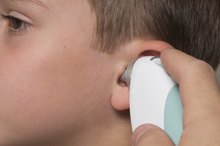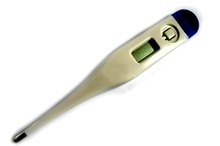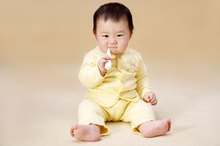Uses of a Clinical Thermometer
Clinical thermometers, also known as medical thermometers or doctors' thermometers, are used to take body temperatures in humans and animals 12. Traditional thermometers use thermometric liquids (i.e., alcohol, mercury) to measure temperature in body cavities -- orally, rectally, vaginally -- or at other axillary points, such as the underarm 12. Many newer thermometers use infrared radiation to record temperature at alternative points, such as the eardrum (tympanic) or forehead 12.
Human Body Temperature
Human body temperature is measured in order to reflect relative health. A significantly elevated (or sometimes lowered) temperature beyond the normal range can indicate illness. Clinical thermometers typically measure a range from 95 to 109 degrees Fahrenheit (or 35 to 40 degrees Celsius) 12. Average normal human temperatures are usually in the 97 to 99 degree range, though fairly significant variations are possible among individuals. Temperatures of 100 degrees or more indicate fever; for infants, fevers of 100.4 degrees or more need immediate medical attention to rule out serious infection.
- Human body temperature is measured in order to reflect relative health.
- Average normal human temperatures are usually in the 97 to 99 degree range, though fairly significant variations are possible among individuals.
Animal Body Temperature
How to Evaluate FSH Level Results
Learn More
Clinical thermometers can also be used to measure body temperatures in animals 12. As in humans, fevers in animals can indicate infections or illness. Few animals will realistically be able to hold thermometers in their mouths in order to register temperature readings 12. Therefore, readings should be taken rectally or tympanically to ensure accuracy. Before attempting to interpret readings, familiarize yourself with the normal range of temperatures for the species of animal in question and be sure that range is reflected on the thermometer intended for use.
Predicting Female Fertility
Women can use thermometers to help predict fertile periods 12. Basal body temperature, or BBT, is the lowest (baseline) temperature reached while resting. BBT is taken around 6 a.m. and after at least five hours sleep. BBT typically spikes at least 0.4 degrees over a 48-hour period when ovulation has occurred. BBT remains elevated until menstruation begins; if pregnant, BBT remains slightly elevated. A woman who uses this method to predict ovulation will need to chart temperatures for several cycles to predict optimal fertility. Once she has ovulated, it is likely too late to engage in intercourse to achieve conception during that cycle; however, she can use BBT to confirm she is ovulating, and to familiarize herself with her cycle.
Special fertility thermometers are available, but standard clinical thermometers are sufficient for measuring BBT 12.
- Women can use thermometers to help predict fertile periods 1 temperature reached while resting.
- Once she has ovulated, it is likely too late to engage in intercourse to achieve conception during that cycle; however, she can use BBT to confirm she is ovulating, and to familiarize herself with her cycle.
Note
Safety 1st Ear Thermometer Instructions
Learn More
Clinical thermometers should be lubricated before anal or vaginal insertion in both humans and animals, and should be thoroughly disinfected and sterilized before and after each use 12.
Related Articles
References
- Syvum: Physics Theory: Thermometers
- One Healthy Lifestyle: Thermometers
- Sulaski Wyckoff A. Thermometer use 101. AAP News. 2009;30(11);29. doi:10.1542/aapnews.20093011-29a
- El-Radhi AS. Determining fever in children: the search for an ideal thermometer. Br J Nurs. 2014;23(2):91-94. doi:10.12968/bjon.2014.23.2.91
- Geijer H, Udumyan R, Lohse G, Nilsagård Y. Temperature measurements with a temporal scanner: systematic review and meta-analysis. BMJ Open. 2016;6(3):e009509. doi:10.1136/bmjopen-2015-009509
- U.S. Environmental Protection Agency. Mercury thermometers. Updated June 26, 2018.
- Stanford Children's Health, Lucile Packard Children's Hospital. Fever in children.
- American Academy of Pediatrics: healthychildren.org. How to take a child's temperature. Updated November 21, 2015.
- Obermeyer Z, Samra JK, Mullainathan S. Individual differences in normal body temperature: longitudinal big data analysis of patient records. BMJ. 2017;359:j5468. doi:10.1136/bmj.j5468
Writer Bio
Annie Lee Tatum has been a freelance writer since 2008. Her poetry and articles have appeared in "Ace Weekly," "Kudzu" and various other publications. Tatum received her Bachelor of Arts from Eastern Kentucky University in 2002 and her Master of Arts from the University of Louisville in 2008. Interests include anthropology and cooking.








